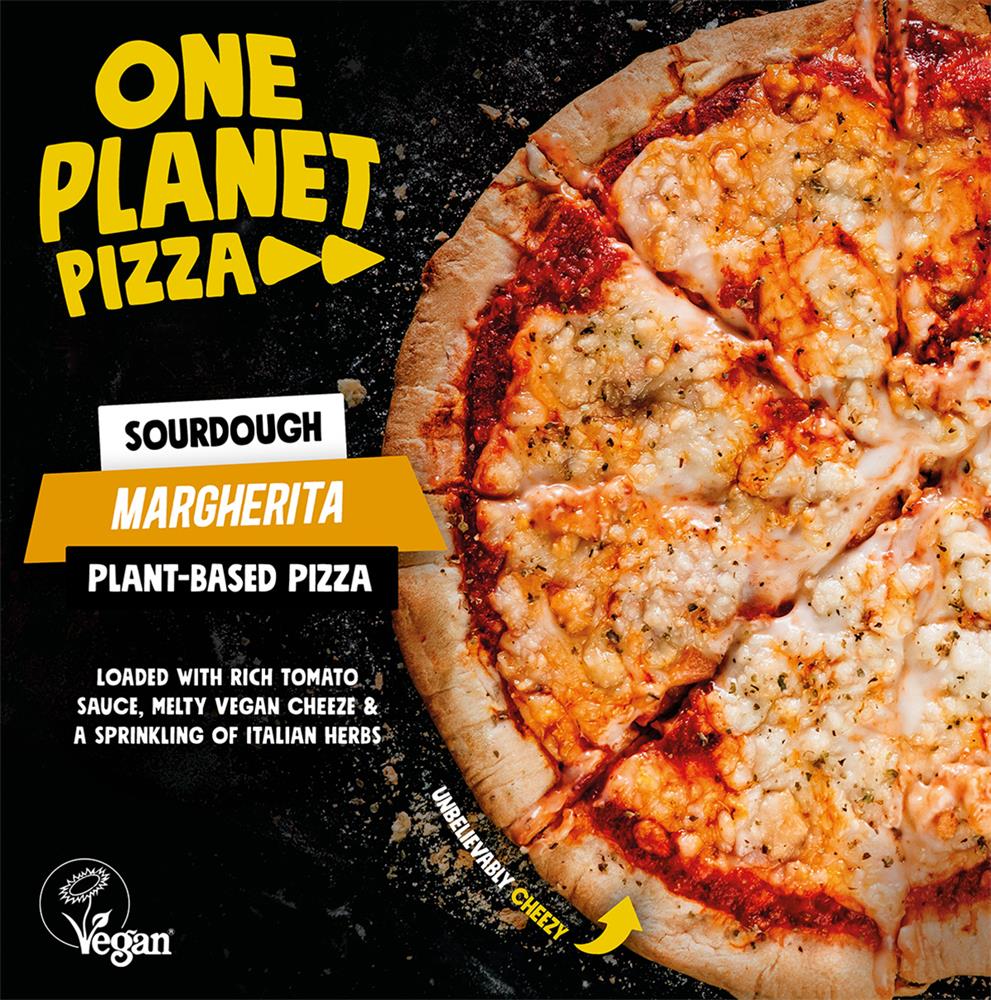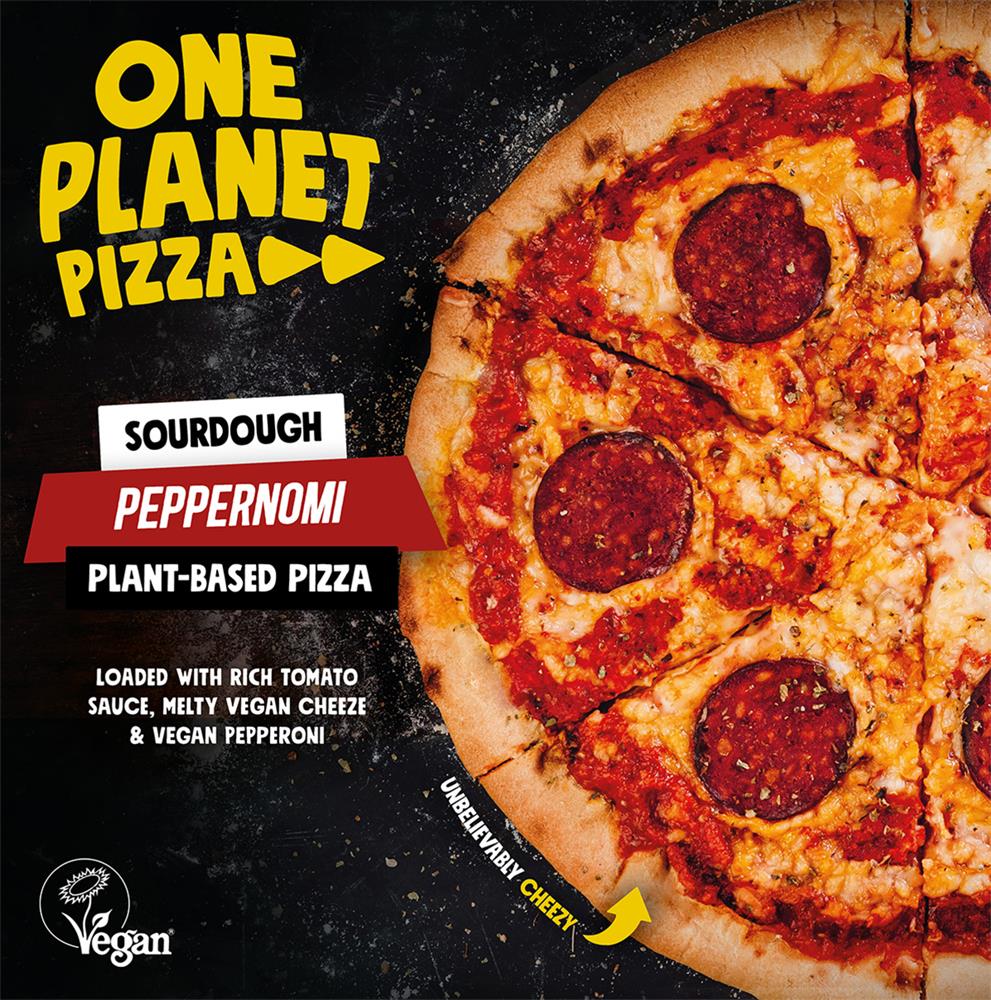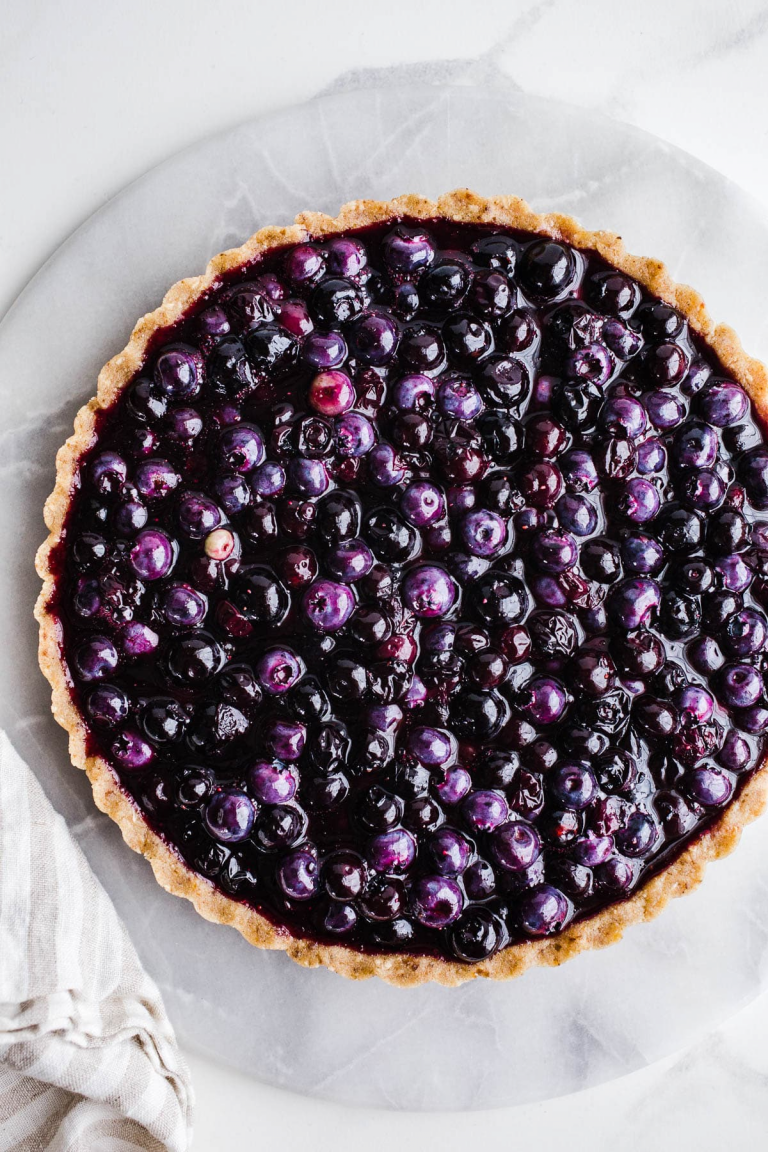
One Planet Pizza is one of the best vegan pizza brands, sold in most supermarkets (find them in the freezer section). Carrying a far lower carbon footprint, these feature wood-fired bases, and are super-tasty with plant-based cheese and meats, for all the flavour but far less calories.
Before cooking, read up on food safety for people and pets.
You can’t recycle greasy parts of pizza boxes (so tear off oily parts and bin, then recycle the rest). Also never give leftover pizza crust to garden birds or wildfowl (it could choke them).
These pizzas are sold in cardboard boxes. This brand also uses an easy-to-recycle plastic inner wrap that you can recycle at kerbside or supermarket bag bins. To cook, bake from frozen for 15 to 20 minutes, following instructions.
The company was created by a vegan father and son, who love pizza. They became obsessed with creating a brand of one of the world’s most popular foods, that was good for people, planet and animals. It’s a fact that most people buy ready-made pizza, so there was a market there.
So this brand swaps expensive ready-made pizzas made with factory-farmed meat and dairy (and unaffordable take-out pizzas) for affordable alternatives that you just keep in the freezer and bake in the oven, when friends are coming. Or there’s a good film on, ideal with pizza and beer!
On average, One Planet Pizzas have a carbon footprint of around 47% less than meat-and-dairy counterparts. This was one of the first crowd-funded vegan brands. Started in a garage in Norwich, the pizzas are now made in The Netherlands, and sold across Europe.
The company has cooked pizza for Mary Berry, the son has appeared on TV judging plant-based cheese, and you can buy this brand everywhere – from independent stores to supermarkets (Booths, ASDA and Morrisons).
Choose from the following flavours:

- Margherita (the classic sourdough base, topped with a family-recipe tomato sauce and plant-based cheese)
- Tex-Mex (tomato sauce on a sourdough base, topped with red onion, sweetcorn, bell peppers, green chilli peppers & plant-based cheese)
- Peppernomi (a secret sauce recipe on a sourdough base, topped with plant-based cheese and smoked vegan pepperoni)
- Hawaiian (tomato sauce topped with plant-based cheese, vegan bacon lardons and pineapple chunks, on a sourdough base). Italians don’t class pineapple as pizza, but who cares, if it saves animals?
These pizzas taste as good if not better than conventional pizzas. No pizza is low-calorie (so don’t eat them every day). But for plant-based pizzas with classic toppings, you won’t find better.
What Makes One Planet Vegan Pizza Special?
The idea grew from two clear trends. Home cooks began to favour local, organic produce and simple doughs. At the same time, sustainable brands promoted plant-based swaps that cut waste and emissions. Put them together and you get a pizza that brings taste, texture, and responsibility to the same plate.
Key features define it:
- Dairy-free cheese, often made from nuts or soy, that melts well and adds richness.
- Plant-based toppings, like mushrooms, peppers, courgettes, olives, and spinach, which bring colour and bite.
- A whole-grain base, often with part wholemeal flour, for fibre and a nutty flavour.
- Seasonal sauces and herbs, like autumn tomato sauce, garlic, basil, and oregano.
Compared to traditional pizza with dairy cheese and processed meats, this version usually carries a lower carbon footprint. Plant foods tend to need less land and water. They also tend to produce fewer greenhouse gases per portion. That means fewer resources per slice, with the joy of a hot, bubbling pizza still intact.
Taste stays front and centre. Roasted vegetables bring depth. Good olive oil adds gloss and aroma. A crisp base offers crunch, while a simple tomato sauce lifts everything. The goal is balance, not sacrifice. You get the comfort you expect, then a little more.
The Eco-Friendly Ingredients Behind the Flavour
- Tomato sauce: Made from seasonal tomatoes or passata, simmered with garlic, onion, and herbs. Seasonal produce supports shorter supply chains and fresher taste.
- Vegan cheese: Cashew-based, almond-based, oat-based, or soy-based options. Some are fortified and melt smoothly. Choose brands that avoid palm oil or pick recipes you can make at home.
- Vegetable toppings: Mushrooms, peppers, red onions, olives, spinach, sweetcorn, artichokes, and cherry tomatoes. Mix raw and roasted for varied texture.
- Flours and oils: Stoneground or wholemeal flour and extra-virgin olive oil bring flavour and nutrition.
- Sourcing: Organic and low-input farms help protect soil life and pollinators. Shorter transport routes reduce emissions. Diverse planting supports biodiversity and can lower water use.
These choices make the pizza taste brighter. Fresh, organic veg tends to have stronger flavour. A whole-grain base adds chew and character. Good sourcing is not only about footprints, it is about better food.
A Quick Look at Its Nutritional Edge
Plant-based pizza can pack a gentle health boost. A whole-grain base adds fibre, which supports digestion and steady energy. Vegetables add vitamins and minerals, like vitamin C, vitamin K, folate, and potassium. Legume or nut cheeses add plant protein and, in many cases, less saturated fat than dairy.
Compared with many regular pizzas, a One Planet Vegan Pizza often has:
- Lower saturated fat from dairy-free cheese.
- Fewer calories per slice when loaded with veg.
- More fibre from whole grains and vegetables.
What does that feel like day to day? You feel full without the slump. Your gut gets support from fibre. Your energy stays more even. No bold medical claims here, just everyday wins from a meal built on plants.
Why One Planet Vegan Pizza Rocks!
Plant-based pizza supports daily life on several fronts. It cuts the footprint of a favourite meal, it can be good for your body, and it respects your budget when you shop smart.
Environmental impact:
- Plant toppings usually need fewer resources than meat and dairy. That lowers emissions per meal.
- Seasonal and local produce often means shorter transport routes and less packaging.
- Whole grains support crop diversity, which is good for soil health.
Health and wellness:
- Higher fibre supports digestion and a steady appetite.
- Lower saturated fat can support heart health over time as part of a balanced diet.
- Colourful vegetables bring antioxidants and a wide spread of vitamins.
Affordability and ease:
- Vegetables, flour, and yeast are low-cost staples. A homemade base reduces price per slice.
- Batch-cook sauce and freeze dough balls for quick weeknight dinners.
- Leftovers reheat well for lunches, saving time and money.
Flexibility for real life:
- Serve at parties with a toppings bar, letting guests build their own.
- Make mini pizzas for children and use it as a chance to talk about food and the planet.
- Keep it simple on busy evenings with a margherita-style pie and a side salad.
Boosting Health and the Planet with Every Slice
Your plate choices add up. Swap dairy-heavy pizza for a plant-based version and you reduce demand for resource-heavy foods. That can mean less pressure on forests for feed and grazing, and more room for nature. At home, you also build habits that support better heart health over time.
Picture a Friday family night. You make dough together, chop veg, and talk about where food comes from. Children learn that tasty food can be kind to the earth. Everyone enjoys a hot slice with crisp edges and bright flavour. That is real progress made in the kitchen.






